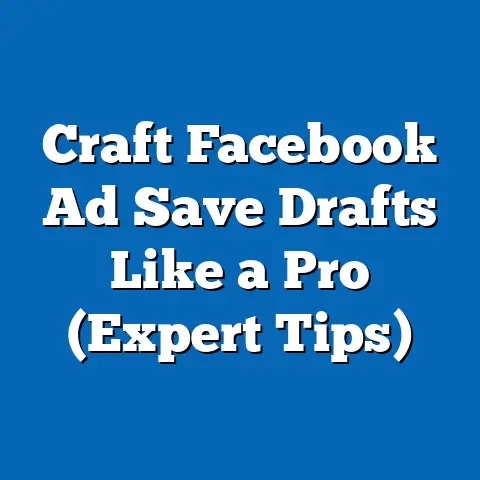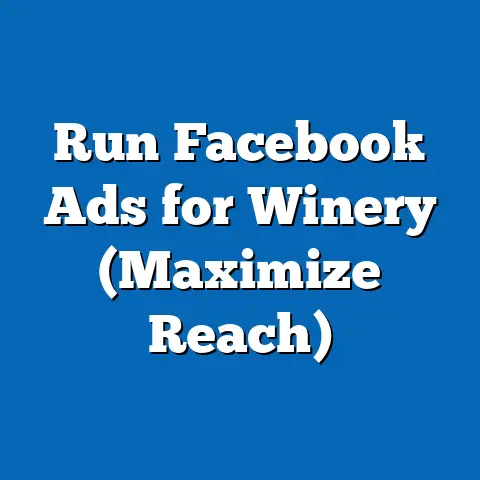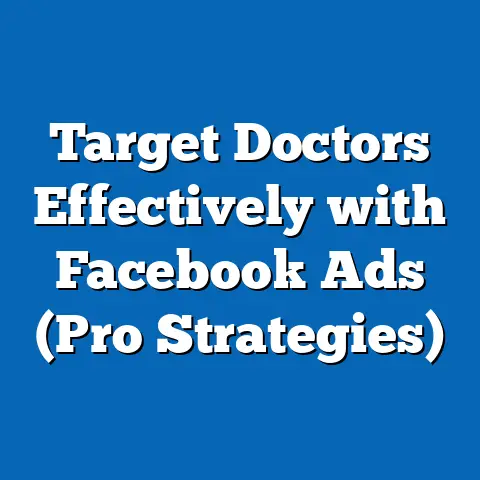Skyrocket ROI with Facebook Ads (Proven Strategies)
As the holiday season approaches, businesses are gearing up for the most crucial time of the year. With consumers actively seeking deals and gifts, leveraging Facebook Ads can be a game-changer for maximizing sales and boosting your bottom line. However, simply running ads isn’t enough. To truly succeed, you need to focus on Return on Investment (ROI) – the ultimate measure of your advertising effectiveness.
Understanding Facebook Ads
Facebook Ads are a powerful tool that allows businesses to reach a massive audience with targeted messaging. With over 2.9 billion monthly active users, Facebook provides unparalleled reach and potential for connecting with your ideal customers.
The beauty of Facebook Ads lies in its versatility. You can choose from various ad formats, each designed to capture attention and drive specific actions:
- Image Ads: Simple yet effective, image ads are perfect for showcasing your products or services with compelling visuals.
- Video Ads: Engaging and dynamic, video ads are ideal for telling your brand story and capturing attention in a crowded newsfeed.
- Carousel Ads: Showcase multiple products or features in a single ad, allowing users to scroll through different images or videos.
- Collection Ads: Designed for e-commerce businesses, collection ads allow users to browse a catalog of products directly within the ad.
But what truly sets Facebook Ads apart is its sophisticated targeting capabilities. You can tailor your ads to reach specific audiences based on demographics, interests, behaviors, and more. This level of precision ensures that your message reaches the people who are most likely to be interested in your offerings.
The Importance of Setting Clear Goals
Before diving into the nitty-gritty of ad creation and optimization, it’s crucial to establish clear, measurable goals. Without a clear objective, you’re essentially shooting in the dark, hoping that your ads somehow generate results.
Setting SMART goals – Specific, Measurable, Achievable, Relevant, and Time-bound – is the key to maximizing ROI. Here are a few examples:
- Brand Awareness: Increase brand reach by 20% within the next quarter.
- Lead Generation: Generate 100 qualified leads per month through a lead magnet campaign.
- Sales Conversions: Increase online sales by 15% during the holiday season.
The type of goal you set will directly influence your ad strategies. For instance, a brand awareness campaign might focus on reaching a broad audience with engaging content, while a sales conversion campaign will prioritize targeting users who are ready to make a purchase.
Proven Strategies to Skyrocket ROI
Now that we’ve covered the basics, let’s dive into the proven strategies that I’ve used to help businesses achieve significant ROI improvements with Facebook Ads.
A. Audience Targeting
One of the most critical aspects of Facebook Advertising is audience targeting. It’s not enough to have a great product and a compelling ad if you’re showing it to the wrong people. I’ve seen firsthand how refined targeting can dramatically improve ad performance and ROI.
- Custom Audiences: These are created from your existing customer data. You can upload email lists, phone numbers, or website visitor data to target people who already know your brand. I once worked with a local restaurant that uploaded their customer email list to create a custom audience. They then ran ads promoting a special discount for returning customers, resulting in a 30% increase in repeat business.
- Lookalike Audiences: This is where the magic truly happens. Facebook uses your custom audience data to find people who share similar characteristics and behaviors. It’s like cloning your best customers! I remember when I first started using lookalike audiences, I was skeptical. But after seeing a campaign generate a 25% higher conversion rate compared to broad targeting, I was a believer.
- Retargeting: This involves showing ads to people who have previously interacted with your website or Facebook page. It’s a powerful way to re-engage potential customers who may have abandoned their shopping cart or shown interest in your products. I had a client in the e-commerce space who implemented a retargeting campaign showcasing the exact products that users had viewed on their website. This resulted in a 15% increase in sales conversions.
Takeaway: Don’t underestimate the power of precise audience targeting. Experiment with custom audiences, lookalike audiences, and retargeting to reach the people who are most likely to convert.
B. Compelling Ad Creative
Even with perfect targeting, your ads will fall flat if they don’t capture attention and resonate with your audience. Compelling ad creative is the heart of any successful Facebook Ads campaign.
- Visuals: High-quality images and videos are essential for grabbing attention in a crowded newsfeed. Use visually appealing graphics that showcase your products or services in the best light. I’ve learned that lifestyle images – those that show your product in use – tend to perform better than product-only shots.
- Copy: Your ad copy should be concise, engaging, and persuasive. Highlight the benefits of your product or service and address the pain points of your target audience. Use strong calls to action that encourage users to take the next step. I once wrote an ad for a local gym that focused on the “transformation” aspect of their program, rather than just listing features. The ad copy resonated with people who were looking to improve their health and fitness, resulting in a significant increase in sign-ups.
- Call to Action (CTA): A clear and compelling CTA is crucial for driving conversions. Use action-oriented language that tells users exactly what you want them to do, such as “Shop Now,” “Learn More,” or “Sign Up.” I’ve found that testing different CTAs can have a significant impact on ad performance.
Takeaway: Invest time and effort in creating compelling ad creative that captures attention, resonates with your audience, and drives action.
C. Optimizing Ad Spend
Effective budget allocation and bidding strategies are crucial for maximizing your ROI. You don’t want to waste money showing your ads to people who are unlikely to convert.
- Daily vs. Lifetime Budgets: Daily budgets allow you to spend a consistent amount each day, while lifetime budgets allow you to set a total budget for the entire campaign duration. I typically recommend daily budgets for ongoing campaigns and lifetime budgets for campaigns with a specific end date.
- Facebook’s Ad Bidding Strategies: Facebook offers various ad bidding strategies, such as lowest cost, cost cap, and target cost. Each strategy has its own advantages and disadvantages, depending on your campaign goals. I’ve found that the “lowest cost” strategy is a good starting point for most campaigns, as it allows Facebook to optimize your bids for the lowest possible cost per result.
- Monitoring and Adjusting Ad Spend: Regularly monitor your ad performance and adjust your budget accordingly. If you’re seeing strong results, consider increasing your budget to reach a wider audience. If your ads are underperforming, you may need to pause them or make adjustments to your targeting or creative. I use automated rules within Facebook Ads Manager to automatically increase or decrease my budget based on performance metrics.
Takeaway: Be strategic with your ad spend. Experiment with different budget allocation and bidding strategies to find what works best for your campaign goals. Regularly monitor your performance and make adjustments as needed.
D. Leveraging Facebook Pixel
The Facebook Pixel is a powerful tool that tracks user interactions on your website, allowing you to measure the effectiveness of your ads and optimize your campaigns for better results.
- Implementing Facebook Pixel: The first step is to install the Facebook Pixel code on your website. This can be done manually or through a plugin, depending on your website platform.
- Conversion Tracking: Once the Pixel is installed, you can track specific actions that users take on your website, such as making a purchase, filling out a form, or adding items to their cart. This data is invaluable for understanding which ads are driving the most conversions.
- Refining Ad Strategies: Use the data from Facebook Pixel to refine your ad strategies. For example, you can create custom audiences based on users who have completed specific actions on your website. You can also use the data to optimize your ad creative and targeting for better performance. I had a client who used Facebook Pixel data to identify the most popular products on their website. They then created ads showcasing these products, resulting in a significant increase in sales.
Takeaway: Implement the Facebook Pixel on your website and use the data to track conversions and refine your ad strategies.
E. Utilizing Facebook Insights
Facebook Insights provides a wealth of data about your audience and ad performance, allowing you to make informed decisions about your future campaigns.
- Analyzing Performance Metrics: Pay attention to key metrics such as click-through rate (CTR), conversion rate, cost per click (CPC), and return on ad spend (ROAS). These metrics will give you a good understanding of how your ads are performing.
- Interpreting Data: Don’t just look at the numbers – try to understand the story behind them. For example, if your CTR is low, it could indicate that your ad creative isn’t resonating with your audience. If your conversion rate is low, it could mean that your landing page isn’t optimized for conversions.
- Making Informed Decisions: Use the data from Facebook Insights to make informed decisions about your future ad campaigns. For example, if you see that a particular audience segment is performing well, you can focus your efforts on targeting that segment. If you see that a particular ad creative is underperforming, you can try a different approach.
Takeaway: Regularly analyze your performance metrics using Facebook Insights and use the data to make informed decisions about your future ad campaigns.
Case Studies of Successful Facebook Ad Campaigns
Let’s take a look at a few real-world examples of businesses that have successfully increased their ROI through Facebook Ads:
- Case Study 1: Local Bakery: A local bakery used Facebook Ads to promote their seasonal treats during the holiday season. They targeted local residents with ads showcasing mouthwatering images of their pies and cookies. They also offered a special discount for customers who ordered online. As a result, they saw a 25% increase in online orders during the holiday season.
- Case Study 2: E-commerce Store: An e-commerce store selling handmade jewelry used Facebook Ads to drive traffic to their website. They created a lookalike audience based on their existing customer data and targeted them with ads showcasing their latest designs. They also implemented a retargeting campaign to re-engage potential customers who had abandoned their shopping carts. As a result, they saw a 15% increase in sales conversions.
Lessons Learned: These case studies demonstrate the power of targeted advertising, compelling ad creative, and effective budget allocation. By focusing on the right strategies, businesses can achieve significant ROI improvements with Facebook Ads.
Conclusion
As we approach the holiday season, now is the time to ramp up your Facebook Ads campaigns and maximize your sales potential. By understanding the fundamentals of Facebook Ads, setting clear goals, and implementing the proven strategies outlined in this guide, you can skyrocket your ROI and achieve remarkable results.
Remember, Facebook Ads is a dynamic platform that requires continuous learning and adaptation. Stay up-to-date with the latest trends and best practices, and don’t be afraid to experiment with different strategies to find what works best for your business.
Ready to take your Facebook Ads campaigns to the next level? Start implementing these strategies today and watch your ROI soar!





